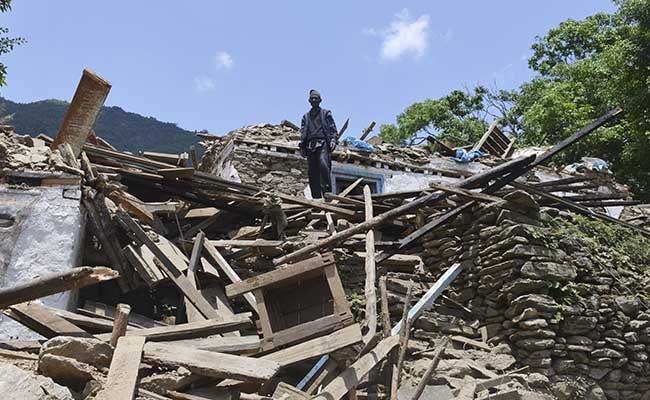
File Photo: Destruction caused in Nepal by the earthquake.
London:
Emergency helicopter services in quake-hit Nepal may be forced to stop within weeks due to a lack of funding, leaving almost 150,000 people without food and shelter to survive the monsoon season, the United Nations warned on Monday.
Annual monsoon rains and resulting landslides could cut off access to remote communities devastated by the two quakes which struck in April and May, making helicopters crucial for reaching them, according to the UN Humanitarian Air Service (UNHAS).
The quakes killed around 8,900 people, injured more than 22,000 and forced tens of thousands into temporary shelters.
"We have pending requests to move about 650 metric tons of emergency supplies, and new requests for the movement of cargo continue to be received daily," said Edmondo Perrone, UNHAS logistics cluster coordinator.
"About 35 organisations are waiting for airlifts, which emphasises how desperate the need is for this service right now," he added in a statement.
The UN helicopter service has only received half the $18 million it needs to operate until the end of October. If the shortfall is not met soon, deliveries will stop at the end of August, UNHAS said.
The service, managed by the World Food Programme, has moved more than 2,600 aid workers and 1,450 metric tons of supplies across Nepal, and delivered aid to 139 remote communities unreachable by road.
Nearly three million survivors - around 10 percent of the Himalayan nation's population - many in mountainous, hard-to-reach areas, need shelter, food and basic medical care, according to a recent UN report.
Nepal's government has estimated the cost of recovery at over $6.6 billion over the next five years, equivalent to one third of its gross domestic product, and has so far received donor pledges worth $4.4 billion.
Nepal says the disaster destroyed more than 500,000 houses and pushed 700,000 more people to poverty. Already one in four of the country's 28 million people lives on a daily income of less than $1.25.
Annual monsoon rains and resulting landslides could cut off access to remote communities devastated by the two quakes which struck in April and May, making helicopters crucial for reaching them, according to the UN Humanitarian Air Service (UNHAS).
The quakes killed around 8,900 people, injured more than 22,000 and forced tens of thousands into temporary shelters.
"We have pending requests to move about 650 metric tons of emergency supplies, and new requests for the movement of cargo continue to be received daily," said Edmondo Perrone, UNHAS logistics cluster coordinator.
"About 35 organisations are waiting for airlifts, which emphasises how desperate the need is for this service right now," he added in a statement.
The UN helicopter service has only received half the $18 million it needs to operate until the end of October. If the shortfall is not met soon, deliveries will stop at the end of August, UNHAS said.
The service, managed by the World Food Programme, has moved more than 2,600 aid workers and 1,450 metric tons of supplies across Nepal, and delivered aid to 139 remote communities unreachable by road.
Nearly three million survivors - around 10 percent of the Himalayan nation's population - many in mountainous, hard-to-reach areas, need shelter, food and basic medical care, according to a recent UN report.
Nepal's government has estimated the cost of recovery at over $6.6 billion over the next five years, equivalent to one third of its gross domestic product, and has so far received donor pledges worth $4.4 billion.
Nepal says the disaster destroyed more than 500,000 houses and pushed 700,000 more people to poverty. Already one in four of the country's 28 million people lives on a daily income of less than $1.25.
© Thomson Reuters 2015
Track Latest News Live on NDTV.com and get news updates from India and around the world

